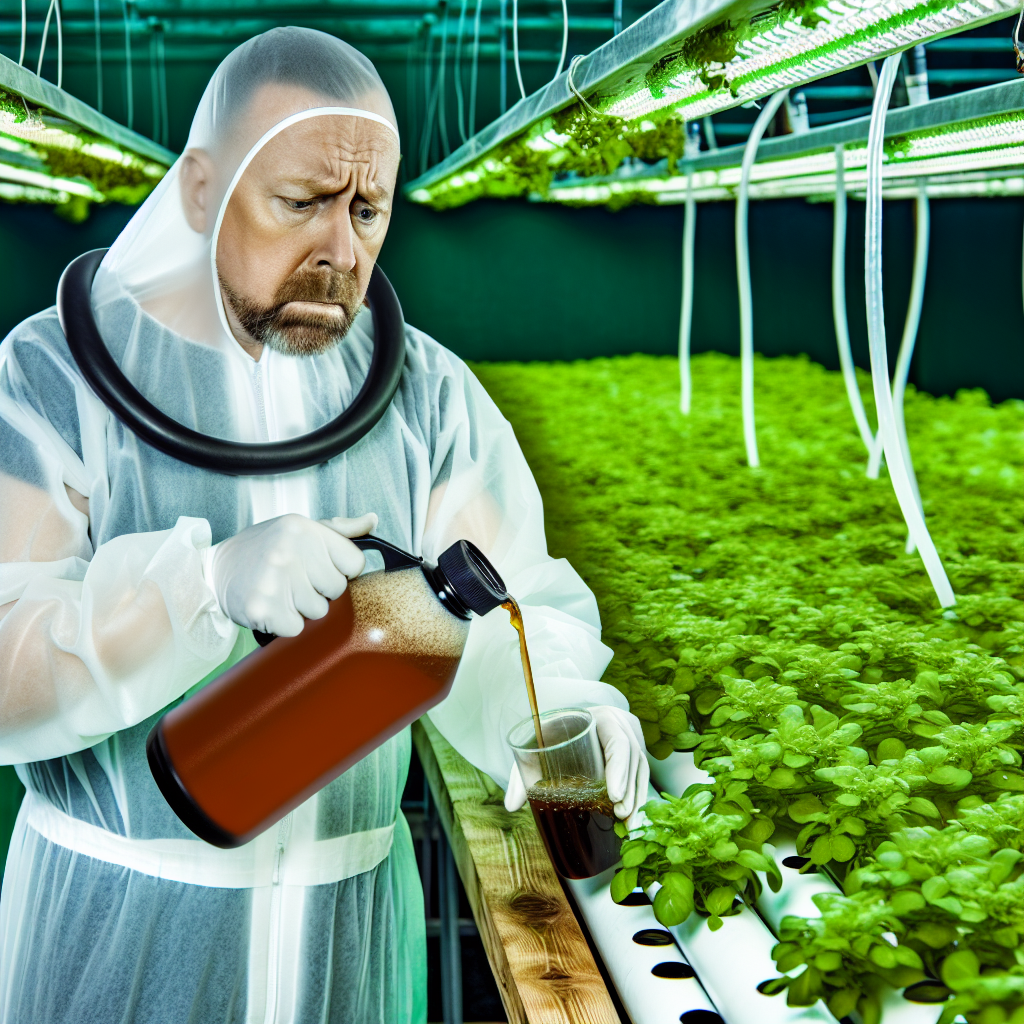Introduction to Hydroponics: Benefits and Challenges
Hydroponics offers a revolutionary approach to agriculture.
This system allows plants to grow without soil.
Instead, it uses nutrient-rich water solutions.
This method significantly increases crop yields.
Moreover, it requires less water compared to traditional farming.
Hydroponics also promotes year-round production.
As a result, farmers can harvest crops more frequently.
Benefits of Hydroponics
Hydroponics brings numerous advantages to producers.
Firstly, it maximizes space efficiency.
Thus, urban areas can utilize smaller plots for farming.
Secondly, this method minimizes pest infestations.
Without soil, harmful insects and diseases are less prevalent.
Additionally, growers can easily monitor nutrient levels.
This creates a healthier growing environment for plants.
Challenges of Hydroponics
Despite its benefits, hydroponics presents challenges.
Transform Your Agribusiness
Unlock your farm's potential with expert advice tailored to your needs. Get actionable steps that drive real results.
Get StartedOne significant concern is the initial setup cost.
Investing in systems and technology can be expensive.
Furthermore, technical expertise is often necessary.
Growers need to understand plant nutrition and water chemistry.
Lastly, system failures can result in rapid crop loss.
Thus, maintaining an efficient operation is crucial.
Overview of Organic Solutions in Hydroponic Systems
Introduction to Organic Hydroponics
Organic hydroponics combines hydroponic techniques with organic growing philosophies.
This approach eliminates synthetic chemicals and focuses on natural inputs.
Farmers utilize various organic solutions to nourish plants and stimulate growth.
Benefits of Organic Hydroponics
Organic hydroponics offers numerous advantages for growers.
First, it promotes sustainable agricultural practices that protect the environment.
Next, organic solutions often enhance flavor and nutritional value in crops.
Furthermore, this method can yield crops free of harmful pesticide residues.
Natural Nutrient Sources
Farmers can select from various natural nutrient sources for their hydroponic systems.
- Compost teas provide essential nutrients and beneficial microbes.
- Seaweed extracts act as a natural growth stimulant and provide minerals.
- Fish emulsion offers a rich nutrient source that supports overall growth.
Microbial Solutions
Utilizing microbial solutions can greatly benefit hydroponic systems.
Beneficial bacteria and fungi help enhance nutrient absorption by plants.
These microbes also aid in disease resistance and promote healthy root growth.
Organic Pest Control
Pest management in organic hydroponics requires careful planning and execution.
Natural insecticides, such as neem oil, serve as effective pest control measures.
Additionally, introducing beneficial insects can maintain ecological balance.
- Ladybugs help control aphid populations effectively.
- Predatory mites can reduce spider mite infestations.
Water Management in Organic Systems
Proper water management is crucial for organic hydroponic success.
Growers should regularly monitor water quality to prevent algae growth.
Implementing a filtration system ensures clean water for plant roots.
Essential Nutrients for Organic Hydroponic Cultivation
Overview of Nutrient Requirements
Plants need essential nutrients for healthy growth and development.
Showcase Your Farming Business
Publish your professional farming services profile on our blog for a one-time fee of $200 and reach a dedicated audience of farmers and agribusiness owners.
Publish Your ProfileThese nutrients play critical roles in metabolic processes.
In organic hydroponic systems, nutrient delivery differs from traditional methods.
Understanding these nutrients ensures successful cultivation.
Macronutrients
Macronutrients are vital for plant structure and function.
They include nitrogen, phosphorus, potassium, calcium, magnesium, and sulfur.
- Nitrogen: Promotes leafy growth and chlorophyll production.
- Phosphorus: Supports root development and flower formation.
- Potassium: Enhances overall plant health and disease resistance.
- Calcium: Strengthens cell walls and aids in nutrient uptake.
- Magnesium: Essential for photosynthesis and enzyme activation.
- Sulfur: Important for protein synthesis and enzyme function.
Micronutrients
Micronutrients are required in smaller quantities but are equally important.
They include iron, manganese, zinc, copper, molybdenum, and boron.
- Iron: Crucial for chlorophyll synthesis and respiration.
- Manganese: Plays a role in photosynthesis and nitrogen metabolism.
- Zinc: Supports hormone production and root growth.
- Copper: Involved in photosynthesis and reproductive growth.
- Molybdenum: Essential for nitrogen fixation and enzyme activity.
- Boron: Important for cell wall formation and reproduction.
Organic Sources of Nutrients
Using organic sources ensures sustainable cultivation.
Composts and natural fertilizers provide a rich nutrient profile.
- Composted Manure: Supplies a balanced mix of macro and micronutrients.
- Seaweed Fertilizer: Rich in trace elements and growth hormones.
- Bone Meal: An excellent source of phosphorus.
- Fish Emulsion: Provides a quick-release source of nitrogen.
Monitoring Nutrient Levels
Regular monitoring of nutrient levels is crucial for plant health.
Testing solutions helps identify deficiencies early.
Adjusting nutrient solutions based on plant needs fosters optimal growth.
Maintaining the right pH level enhances nutrient availability.
Implementing Fertigation
Fertigation combines irrigation with nutrient delivery.
This method ensures efficient nutrient uptake by plants.
Adjusting the concentration of nutrients can tailor to specific growth stages.
Regular feedback from plant performance can enhance this process.
Delve into the Subject: Enhancing Soil Health with Strategic Mulching
Natural Pest Management Techniques for Hydroponic Gardens
Introduction to Natural Pest Control
Natural pest management focuses on using eco-friendly methods.
This approach minimizes chemical use in hydroponic gardens.
Understanding pest behavior is key to effective management.
Utilizing Beneficial Insects
Introduce predators like ladybugs and lacewings to gardens.
These insects feed on common pests such as aphids and spider mites.
Encouraging parasitic wasps can control caterpillar populations.
Ensure a habitat exists for these beneficial insects.
Implementing Organic Spray Solutions
Use organic sprays made from neem oil for pest control.
This oil disrupts pests’ life cycles effectively.
Incorporate insecticidal soaps to manage soft-bodied insects.
Avoid spraying during peak sunlight to protect plants.
Creating Physical Barriers
Install row covers or mesh nets to shield plants from pests.
These barriers prevent insects from reaching the plants.
Regularly check for any damages to these protective coverings.
Attracting Natural Predators
Plant flowers that attract pollinators and beneficial insects.
Consider marigolds or calendula for their pest-repelling properties.
Maintaining diverse plant life promotes a balanced ecosystem.
Employing Companion Planting
Companion planting can deter pests through scent or chemicals.
Planting basil alongside tomatoes can repel aphids.
Garlic and onions can protect neighboring plants from other pests.
Regular Monitoring and Maintenance
Consistently inspect plants for early signs of pests.
Remove affected leaves to prevent pest spread.
Showcase Your Farming Business
Publish your professional farming services profile on our blog for a one-time fee of $200 and reach a dedicated audience of farmers and agribusiness owners.
Publish Your ProfileTrack pest populations to determine control strategies.
Maintain cleanliness in the garden to deter unwanted visitors.
Gain More Insights: Sustainable Practices for Post-Harvest Processing
Organic pH Management in Hydroponic Systems
Importance of pH in Hydroponics
pH levels significantly impact nutrient availability in hydroponic systems.
A proper pH ensures plants absorb nutrients effectively.
Inadequate pH levels can hinder plant growth and yield.
Therefore, understanding pH is crucial for hydroponic success.
Ideal pH Levels for Different Plants
Various plants thrive at specific pH ranges.
For instance, lettuce prefers a pH between 5.5 and 6.5.
Tomatoes, on the other hand, thrive in a pH range of 5.8 to 6.2.
Knowing your plants’ needs helps maintain optimal conditions.
Organic Methods for pH Management
Using organic inputs can effectively manage pH levels.
Natural amendments like lime can raise pH levels.
Conversely, sulfur can lower pH levels organically.
Both options support sustainable hydroponic practices.
Monitoring pH Levels
Regular monitoring is essential for managing pH levels.
Invest in a reliable pH meter for accurate readings.
Test your solution at least once a week or more frequently as needed.
This practice helps prevent unexpected pH fluctuations.
Adjusting pH Levels
Adjustments can be made based on pH readings.
If the pH is too high, consider adding organic acids.
You can use substances like citric acid for this purpose.
For low pH, organic buffers like potassium bicarbonate are effective.
Common Challenges and Solutions
pH management can present challenges in hydroponics.
One common issue is rapidly changing pH levels.
This can occur due to nutrient uptake by plants.
Regular checks and timely adjustments can counteract this challenge.
Educating Yourself for Better Results
Continual learning enhances pH management skills.
Consider joining workshops or webinars focused on hydroponics.
Online resources and communities can provide valuable insights.
Stay updated on best practices in organic hydroponic cultivation.
Find Out More: Using Technology to Enhance Post-Harvest Management

Utilizing Compost and Vermicompost in Hydroponics
Understanding Compost in Hydroponics
Compost enriches nutrient solutions in hydroponic systems.
It enhances microbial activity and soil structure.
This natural fertilizer supports plant health and growth.
Compost provides essential nutrients like nitrogen, phosphorus, and potassium.
Benefits of Using Compost
Using compost reduces dependence on synthetic nutrients.
This approach promotes sustainable agriculture practices.
- Improves water retention in growing media.
- Enhances beneficial microbial populations.
- Reduces pests and diseases in plants.
Integrating Vermicompost in Hydroponics
Vermicompost is made from worm castings.
It offers higher nutrient content compared to traditional compost.
Showcase Your Farming Business
Publish your professional farming services profile on our blog for a one-time fee of $200 and reach a dedicated audience of farmers and agribusiness owners.
Publish Your ProfileThis organic solution introduces beneficial microorganisms to the system.
Vermicompost promotes healthier root systems.
Advantages of Vermicompost
Incorporating vermicompost enhances nutrient absorption.
It also boosts plant growth and yields significantly.
- Increases the availability of micronutrients.
- Improves seed germination rates.
- Supports microbial diversity in growth media.
Application Techniques
Mix compost and vermicompost into the nutrient solution.
Use in small quantities to avoid nutrient overloading.
Monitor plant response for adjustments as needed.
Combine with other organic materials for optimal results.
Choosing Quality Compost and Vermicompost
Select certified organic compost and vermicompost products.
Check for consistency and nutrient content.
Consult local regulations to ensure compliance.
Research trusted suppliers to guarantee quality input materials.
Delve into the Subject: Preventing Soil Erosion in Organic Farming Systems
Key Organic Additives and Their Benefits for Plant Growth
Enhancing Nutrient Availability
Organic additives boost nutrient availability in hydroponic systems.
They improve the soil’s microbial activity, aiding nutrient uptake.
For instance, compost tea enriches nutrient profiles significantly.
This enhances plant growth and increases yield potential.
Improving Soil Structure
Organic materials improve soil structure and aeration.
They enhance drainage, preventing root rot in hydroponic setups.
Additionally, better soil structure supports healthier root development.
As a result, plants absorb nutrients more effectively.
Boosting Plant Resilience
Organic additives help plants develop resilience against pests.
For example, neem oil wards off harmful insects naturally.
Moreover, compost enriches the soil, enhancing plant health.
This increased resilience leads to better survival rates.
Stimulating Microbial Activity
Organic additives increase beneficial microbial activity in hydroponics.
Bacteria and fungi promote nutrient cycling and availability.
This enhanced microbial life supports overall plant health.
Healthy microbe populations also suppress soil-borne diseases.
Examples of Effective Organic Additives
- Compost tea enhances nutrient richness and microbial activity.
- Fish emulsion provides a balanced nutrient profile.
- Seaweed extracts boost plant growth hormones.
- Molasses feeds beneficial bacteria in the system.
Implementing Organic Additives
Using organic additives effectively requires planning.
It is essential to monitor the nutrient levels regularly.
Incorporate additives gradually to avoid nutrient imbalances.
Furthermore, assessing plant responses helps optimize usage.
Case Studies: Successful Organic Hydroponic Farms
Green Fields Hydroponics
Green Fields Hydroponics operates in the heart of California.
This farm focuses on purely organic practices.
The team utilizes natural fertilizers derived from plant materials.
Many visitors appreciate their eco-friendly approach.
They integrate beneficial insects to control pests effectively.
With this method, they avoid chemical pesticides entirely.
This farm’s yield has tripled over the past five years.
Showcase Your Farming Business
Publish your professional farming services profile on our blog for a one-time fee of $200 and reach a dedicated audience of farmers and agribusiness owners.
Publish Your ProfileConsequently, their produce is now a favorite at local markets.
Urban Eden Farms
Urban Eden Farms thrives in an urban setting.
The team grows a wide variety of leafy greens and herbs.
Their hydroponic systems use recycled water for maximum efficiency.
They boast impressive growth rates, often surpassing traditional farms.
Moreover, they emphasize community engagement through workshops.
These workshops educate others on organic hydroponic techniques.
Also, their products are available through a local subscription service.
This model fosters sustainability and supports local economies.
Blue Sky Hydroponics
Blue Sky Hydroponics is located in the Midwest.
This farm specializes in tomatoes, peppers, and cucumbers.
They steer clear of synthetic fertilizers, choosing organic alternatives.
Moreover, they make their compost on-site to enrich growth.
The farm also uses solar power to offset energy needs.
This commitment helps reduce their carbon footprint significantly.
Customers appreciate their commitment to sustainability.
Their produce is often sold at regional farmers’ markets.
Sunny Acres Farm
Sunny Acres Farm is one of the pioneers in organic hydroponics.
Established over a decade ago, they lead in innovative practices.
Their research and development team experiments with new crops.
As a result, they have developed unique blends of nutrients.
These blends enhance flavor and nutritional value.
Moreover, Sunny Acres collaborates with local universities.
This partnership drives research on soil-less cultivation methods.
Their expertise attracts aspiring farmers from all over the country.
Additional Resources
Hydroponics | National Agricultural Library
Integrating Small-Scale Hydroponics into the Urban Agroecological …




